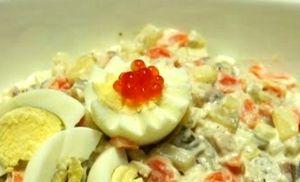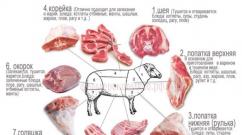Alexander 2 and Maria Fedorovna. The dramatic fate of Nicholas IIO's mother, from the bride of two crown princes to the “angry empress”
The wife of Tsar-Peacemaker Alexander III had a happy and at the same time tragic fate
Photo: Alexander GLUZ
Change text size: A A
Eleven years ago, on September 28, 2006, a coffin containing the remains of Alexander III’s wife, Maria Fedorovna, was buried in the Peter and Paul Cathedral. A few days earlier, the coffin was delivered from Denmark, the empress's homeland. Thus, the will of the monarch’s wife was fulfilled: to be buried next to her husband.
The ceremony was quite modest. Patriarch of Moscow and All Rus' Alexy II, Metropolitan of St. Petersburg and Ladoga Vladimir, members of the Romanov family were present. A white marble tombstone with a gilded cross on top was installed on the grave, identical to the tombstones in the imperial tomb.
Eight years earlier, here, in the Peter and Paul Cathedral, in the presence of the then Russian President Boris Yeltsin, the remains of Maria Feodorovna's son, Emperor Nicholas II, her daughter-in-law and granddaughters were buried. True, discussions about who these remains actually belong to still continue.
Should have married my older brother...
...She was adored in her native Denmark, immediately accepted and loved in Russia, always mysterious to foreigners. She was an ardent bride, a tender and devoted wife, a loving and affectionate mother.
Her name was Sofia Frederika Dagmara, she was born in Copenhagen, the daughter of Prince Christian of Luxembourg, later King Christian IX of Denmark.

Princess Dagmara was not even eighteen years old when her marriage to the heir was decided Russian throne, the eldest son of Emperor Alexander II, Tsarevich Nikolai Alexandrovich. That rare case when young people, matched for dynastic reasons, immediately sincerely fell in love with each other. They became engaged in 1865, while he was traveling in Europe. But soon the Tsarevich fell seriously ill. Doctors diagnosed him with tuberculous meningitis. His brother Alexander Alexandrovich arrived in Nice, where the heir was hastily sent for treatment. Together with Princess Dagmara, he looked after the sick.
It was then, near the bed of his dying brother, that the future Russian Emperor Alexander III felt that his heart was filled with love for this fragile girl. And in his thoughts Alexander did not allow blasphemous desires: with all his soul he wished for his brother’s recovery. But Nikolai himself soon realized that he was doomed. The illness burned him, and two days before his death he told his brother: “Sasha, don’t leave Mini! (this is how Princess Dagmara was nicknamed in the Romanov family - Author). Be her protection and support... If she is dear to your heart, marry her! Mini, become a good wife to him.” The future emperor was silent, stunned and depressed, and Dagmara, sobbing, exclaimed: “Come to your senses! You will definitely get better!”
After the death of his betrothed, Alexander did not speak about the will of his dying brother. But he tried in every possible way to please Dagmara: he gave flowers, knowing that she loved music very much, he took performances to concerts, and he brought books. And the heart of the young Danish woman thawed! The huge and powerful young man, next to whom she was like a thin stalk, turned out to be a wise and kind man, capable of understanding her soul...
The engagement took place in Copenhagen, and the wedding took place in the Church of the Winter Palace. This happened on October 28 (November 9 according to the new style) 1866. The princess converted to Orthodoxy and became Maria Feodorovna.
Did not interfere in government affairs
Almost fifteen years later, after the death of Emperor Alexander II, who was killed by the Narodnaya Volya, his son inherited a difficult inheritance: the empire was rocked by unrest and conspiracies. Alexander Alexandrovich managed to strengthen the power, thereby delaying its collapse. During the reign of the Tsar the Peacemaker, Russia did not wage wars, but industry and National economy developed at a rate that alarmed the Western world.
The Empress always understood her husband well, but she never interfered in his affairs or tried to influence the decisions he made.
But, without touching on state affairs, Alexandra Fedorovna brought considerable benefit to her new Fatherland. On her initiative, girls' schools were opened. Under the patronage of the queen, in particular, were the Alexander Lyceum, St. Petersburg and Moscow commercial schools, the Gatchina Orphan Institute, and charitable societies.
Maria Fedorovna was, in addition, a talented artist. The portraits, still lifes, and plot sketches she created have been preserved.
Without relying only on tutors and teachers
The Emperor and Empress had six children: Nicholas, the future Emperor Nicholas II, Alexander, George, Ksenia, Mikhail and Olga. Alexander died in infancy, George did not live to be thirty years old. Mikhail shared the fate of his crowned older brother: he was shot in 1918. Ksenia and Olga lived to a ripe old age and died abroad.

According to the memoirs of contemporaries, Maria Feodorovna actively participated in the upbringing of her sons and daughters, not relying only on tutors and teachers. However, she never sought to suppress the will of the children. In this regard, the story of the matchmaking and marriage of her eldest son, the heir Nikolai Alexandrovich, is indicative.
In 1894, the Tsarevich met in Crimea the German Princess Victoria Alice of Hesse-Darmstadt, who had come to stay with her Russian relatives. The twenty-six-year-old heir quickly fell in love with a beautiful and intelligent girl. The future emperor told his parents that he was going to woo and get married.
The Emperor and Empress were against this marriage. Alexander III, among others, put forward this very compelling argument. Alice was the granddaughter of Queen Victoria of England and, as doctors claimed, probably inherited from her terrible disease– hemophilia. That is, a crowned couple may have terminally ill sons. And this is a threat to yourself To the Russian state! Maria Fedorovna shared her husband's concern. But, after listening to her son, she firmly told the monarch: “If he loves, then let him marry! We can’t make our son unhappy when we ourselves have been living happily for so many years!”
The imperial couple were not bothered by the heir’s contacts with the ballerina.
Here we cannot help but say about the empress’s attitude towards the love affair between the heir to the throne and the ballerina Matilda Kshesinskaya. Speaking the language Soviet era, V Lately this topic evokes an unhealthy interest that resembles mass insanity. Meanwhile, according to historians, the king and queen did not attach of great importance this son's hobby.
Nikki’s contacts with Matilda did not alarm anyone, because it was clear that marriage was out of the question, Doctor of Historical Sciences Vladlen Izmozik told Komsomolskaya Pravda. - The marriage of the heir to the throne was a matter national importance. Another question is that the young man needed to gain sexual experience, and in decent families this role was performed by milliners, maids, seamstresses, and finally, ballerinas.
In Valentin Pikul’s sensational novel “At the Last Line,” which is dedicated to the events preceding the collapse of the Russian Empire, there are the following lines: “The Tsarina spoke with Madame Myatlyova, who had a broken daughter and four dachas on the Peterhof highway, costing 100,000 rubles . “And I will pay you three hundred thousand for these dachas,” said Tsarina Myatlyova, “but you must close your eyes to the behavior of your daughter... What if my Niki needs a hygienic prelude to marriage!”
The October Revolution was met in Crimea
On October 20 (November 1, new style), 1894, having lived only 49 years, Emperor Alexander III died. And then everything went downhill. Revolutionary fever gripped Russia, terrorists killed one after another statesmen. The courtiers who came into contact with all kinds of conspirators betrayed Emperor Nicholas II. How it all ended is well known.
In October 1917, the Dowager Empress Maria Feodorovna, along with her daughters and a small group of relatives, was in Crimea. A few months earlier she last time I saw my eldest son: I went to see him at Headquarters, in Mogilev.
In Crimea, the Bolsheviks put the former empress and her relatives under House arrest. Eyewitnesses recalled that during the search, the Bible was snatched from Maria Fedorovna’s hands. She begged him to leave her the book. And she heard in response: “An old woman your age has no business reading such nonsense!”
It's hard to say what saved their lives. They say that this was done by the head of the guard named Zadorozhny, who probably only posed as a Bolshevik...
In 1919, the British, finally remembering that the Romanovs were close relatives of them royal family, they sent the cruiser Marlboro for the Dowager Empress: at that moment Crimea was in the hands of the White Guards. But she categorically refused to leave Russia unless all her relatives who were on the peninsula were allowed to emigrate. Allowed!

Photo: Wikipedia. The former empress aboard the cruiser Marlboro
Here the question arises: why didn’t the British Lion bother to save Emperor Nicholas II himself and his family:
“I understand that in 1917 the British authorities sought at all costs to keep Russia in the world war,” says Professor Izmozik. – And in order not to displease the Provisional Government, they gave up on the fate of the Russian monarch.
“Impostors” annoyed me
Maria Fedorovna did not remain in England for long. She left for her homeland, Denmark, where she lived her last years, not succumbing to the persuasion of emigrant circles to join political activities.
But even more annoying than the politicians, she was besieged by “impostors”: her “granddaughters” who allegedly miraculously escaped execution. One young lady who claimed that she was Grand Duchess Anastasia Nikolaevna, the empress said: “Young lady! You are still very young. You will have time to achieve success. But I’m not your helper: we both know very well that you are not my granddaughter!”
I didn’t believe in my son’s death
When the Empress settled in Copenhagen, a colonel who had arrived from Russia, sent to Denmark by Alexander Kolchak, wanted to visit her. He brought the results of an investigation proving the death of the royal family. But Maria Feodorovna refused to accept the messenger. She stated that she did not believe in the death of the family and forbade serving a memorial service for the murdered.
Marrying the Danish king Christian IX, Louise of Hesse-Kassel did not suspect that many years later her grandchildren, cousins Nicholas II and George V, who were as similar as two peas in a pod, would become the heads of the most powerful empires of the Entente. Louise’s connections allowed her and King Christian to become, as they said on the sidelines of many European courts, “the mother-in-law and father-in-law of all of Europe.” But it was precisely the marriage of Maria Sophia Frederica Dagmar, who went down in history under Orthodox name Maria Feodorovna, her parents had high hopes, because an alliance with the Russian Empire could strengthen the position of Denmark, whose lands were continually encroached upon by Prussia and Austria-Hungary in the 19th century.
Dagmar was born in 1847 in Copenhagen. Since childhood, she studied languages, under the guidance of her strict mother, she learned the art of managing a household, and practiced painting and handicrafts. The princess was a passionate equestrian; numerous photographs of her on horseback have survived to this day. When in September 1864, with the blessing of her parents, Tsarevich Nicholas, the heir to the Russian throne, proposed to her, Dagmar actively began to study the Russian language and culture, and memorize Orthodox prayers.
Although their marriage was largely political decision, the young people fell in love with each other, as evidenced by their tender correspondence. But the wedding, scheduled for September 1865, was not destined to take place. In April 1865, the Tsarevich died suddenly in Nice from inflammation of the spinal cord. Neither best doctors, nor the care of his brother and devoted bride could save the crown prince. According to legend, when he was dying, he asked his younger brother Alexander to take care of Dagmar and become her husband, but it is unknown whether such a conversation actually took place.
Be that as it may, the decision to marry the new heir to the throne, Alexander Alexandrovich, and the Danish princess was soon made: in response to the invitation of Empress Maria Alexandrovna to stay with her daughter in Peterhof, the Danish Queen Louise replies that Dagmar is still in mourning, but “continues to teach Russian". She continued her correspondence with the father of both of her suitors, Emperor Alexander II.
In the summer of 1866, after an engagement in the Danish capital, the princess sailed to her new homeland, where she soon converted to Orthodoxy and henceforth began to be called Maria Feodorovna. The entire local intelligentsia gathered to see her off to Russia; Hans Christian Anderson, who often visited Bernstorf during the princess’s childhood, remembers this moment with sadness. The wedding took place on October 28, 1866 in the Winter Palace. So she became the wife of Alexander 3.
Maria Feodorovna faced many trials in Russia. She saw her father-in-law die from a terrorist bomb in 1881. In 1887, there was almost an attempt on the life of Alexander III. And in 1888, a derailed train almost killed the whole family. Six years later, the empress’s beloved husband dies, and her eldest son, whom his mother continued to call Niki, ascends the throne.
Maria Feodorovna was one of the most revered empresses in all layers of Russian society. She became the mother of six children (including Nicholas 2). Together with Alexander 3, she took an active part in creating the funds of the Russian Museum, and headed numerous charitable societies both in peacetime and during the First World War (already as the Dowager Empress). I personally worked in hospitals. Charitable activities continued even in immigration, having very meager means of subsistence.
Until her death, Maria Fedorovna did not believe in the death of her eldest son and his family. However, after listening to the persuasion of numerous relatives, she left Russia in 1919, believing that this was only temporary. After staying with her sister in Great Britain, she returned to her native Denmark, and in 1928 she died not far from the place where she was born. In 2006, her remains were transported to Russia, where, according to Maria Feodorovna’s last will, they were reburied in the Peter and Paul Fortress next to the body of her husband.
The biography of this amazing woman - the most influential empress of the Russian Empire - is filled with happy events and sorrowful experiences. Maria Sophia Frederica Dagmar outlived two lovers: Tsarevich Nikolai Alexandrovich and the emperor, and also learned about the execution of her own son and the entire royal family.
Childhood and youth
On November 26, 1847, in the Bergum mansion, located in Copenhagen, a girl, Maria Sophia, was born to the Danish king Christian IX and his wife Louise of Hesse-Kassel, the second of three daughters (there were six children in the family). Unfortunately, there is not much information about Dagmar’s childhood and youth. It is known that the girl was a favorite in the house, although she was not distinguished by a brilliant mind or exceptional beauty, but due to her innate charm she could please almost everyone.
Young Dagmar loved to play the piano and read classic literature. The princess's favorite writer was a French novelist who wrote philosophical stories about gravity female destiny. WITH early age Maria Sofia knew that, according to tradition, she was destined to marry not for love, but for convenience: it’s no secret that representatives of different royal dynasties tied their blood ties to maintain both external and domestic policy.

In addition, South Scandinavian beauties were especially popular among European grooms at the “bride fair,” since an alliance with a Danish woman guaranteed that the future owner of the throne would not meddle in royal affairs. But it is worth noting that the 16-year-old lady was sincerely happy for her sister Alix, who in 1863 accepted a marriage proposal from the heir to the British crown, Prince of Wales Albert Edward.
Empress
Young Maria Sofia was famous for her temperament both in her native country and abroad - they had heard a lot about the girl’s character in Russia. At that time, the All-Russian Emperor, together with his wife, was just looking for a future chosen one for Tsarevich Nicholas. By the way, Nyx (that was the name of the heir in family circle) was the beloved eldest son in the Romanov family: he personified integrity, honesty, and also had an extraordinary mind and good appearance.

It is known that the Danish-Russian alliance was mutually beneficial. He gave Russia the opportunity to establish family ties With European countries, including Great Britain, with which relations, to put it mildly, did not work out. According to rumors, she did not like Russia because she was rejected by the young Alexander II. For Denmark, unity with Russia would also be beneficial: the Scandinavian country did not dominate foreign policy, so it needed a strong ally.

The last word remained with Nix: when the young crown prince was shown a photograph of Dagmar, the girl made an indelible impression on him, but to his brother, Alexander Alexandrovich, the Danish princess seemed like an unremarkable young lady. In 1864, the heir to the Russian crown went abroad, where on his birthday (September 20) he was engaged to Maria Sofia. However, the union of lovers did not last long.

While traveling in Italy, the Tsarevich unexpectedly fell ill. Soon the doctors announced the heir terrible sentence– tuberculous meningitis. Since the autumn of 1864, Nix has been treated in Nice, but a year later the young man’s health begins to deteriorate sharply. On the night of April 12, after four hours of agony, the successor of Alexander II died. It is noteworthy that Dagmar and the heir’s brother looked after Nikolai Alexandrovich together: according to legend, the three of them held hands on their deathbed. Last words dying man: “Stop the car!”

Thus, after the death of Nix, Alexander Alexandrovich became crown prince. But in Russian family They didn’t forget about the modest Danish woman: Alexander II demanded that his son marry the princess. However, the successor referred to the fact that he was not ready to be the heir to the throne. In addition, Alexander Alexandrovich’s heart was occupied by Maria Meshcherskaya, his mother’s maid of honor.

Alexander told his parents about his love, but they insisted that their son visit Copenhagen in order to win Dagmar’s favor. The Tsarevich was determined, but after a serious conversation with his father he finally gave in: Alexander left for Denmark, and his beloved princess was exiled to Paris and married off.

Alexander did not know what feelings Minnie had for him (as Maria Sofia was called in the Romanov family), so for a long time he did not dare to talk to the Danish woman, although they were often alone and looking at photographic albums. On one of these days, the beauty threw herself on the neck young man and began to cry: her soul was tormented by memories of Nyx. General grief brought the princess and the future emperor closer together, so Dagmar and Alexander soon fell in love with each other. In the summer of 1866, the lovers got engaged in the capital of Denmark, and in the fall Dagmar converted to Orthodoxy, becoming Grand Duchess Maria Feodorovna.

By the way, Maria Fedorovna was initially stunned by the decoration and luxury of the Russian court. It is noteworthy that the life of royal families in some European countries was fundamentally different from the life inherent in those close to the throne of the Russian Empire. For example, the obligatory publicity that royal families needed to maintain traditions was often perceived by monarchs as a heavy burden. Therefore, Dagmar had difficulty adapting to the new environment and new environment. Some rules were strange to the princess: for example, she did not know that she could not choose a dress for the evening on her own, and also did not realize that starting a conversation with the emperor first was a strict prohibition.
Family relationships
The cheerful and modest princess was warmly received in the court and capital societies. Although the relationship between Maria Feodorovna and Alexander did not begin on a happy note, subsequently the husband and wife had the strongest affection for each other. The future emperor tried to spend all his time with his wife: they went hunting and fishing, and also traveled around the city and saw the sights, for example, they visited the Peter and Paul Cathedral, where Nix was buried.

The main place of residence of the lovers was Gatchina. Sometimes they lived in Peterhof and Tsarskoe Selo, and when coming to St. Petersburg, they stayed in the Anichkov Palace. Dagmar bore the emperor six children, among whom was the future heir to the throne, Nikolai Alexandrovich (Nicholas II).
Reign of Alexander III
During the reign of Alexander III, Maria Fedorovna patronized the arts: the politician was a frugal person (for example, balls were held no more than four times a year), but a significant share of the budget was spent on paintings. Dagmar spent most of her time on family obligations, since the emperor suppressed any attempts by the princess to interfere in state and official affairs. Rumor has it that Alexandra's beloved disliked Germany because, in her opinion, this country influenced the emperor's foreign policy.

Autumn 1894 Grand Duke died in the Livadia Palace due to progressive kidney disease, which began to develop after a train crash near Borki station. Royal family remained alive thanks to Alexander, who managed to hold the collapsed roof of the carriage on his shoulders. But this feat had a dramatic impact on the leader’s health.

Alexander III died painfully and for a long time, and Maria Feodorovna (who was with her husband all this time) experienced the same feelings as back in 1864, when she watched Nix fade away. It is known that when the emperor’s heart stopped, Dagmar lost consciousness.
Reign of Nicholas II
Two hours after the death of Alexander III, Russia meets the new emperor - Nikolai Alexandrovich. Unlike his father, the new ruler was not so decisive in state affairs.

During the reign of Nicholas II, his mother also tried not to interfere with Dawesization, but the woman was upset by the surrounding reality: unsuccessful Russo-Japanese War, the difficult situation of industry and Agriculture, etc.; Moreover, under Nicholas, the first shoots of the October Revolution were emerging in the country, popular unrest was growing, and the general political situation was becoming more complicated.

According to rumors, the widow patronized the Minister of Finance Sergei Yulievich Witte and did not like her daughter-in-law - according to Dagmar, this secretive girl could not be a strong support for her husband. Among other things, Maria Fedorovna was a supporter of the women's patriotic society, was involved in charity work, and also personally helped wounded soldiers during the First World War.
Revolution
Reason February Revolution became internal and foreign policy Nicholas II. People's movement grew like a tsunami: workers went on strike at factories, riots broke out in the streets, and demonstrative marches and clashes with the police only added fuel to the fire. According to society, to save Russian Empire and the dynasty could only have one thing: the abdication of Nicholas II from the throne.

Therefore, on the afternoon of March 15, the emperor renounces the Russian crown in favor of Tsarevich Alexei under the regency of Mikhail Alexandrovich. Maria Feodorovna learns about this fateful event in Kyiv and leaves for Mogilev to see her son. Then the widow goes to Crimea, later to Great Britain and finally stops in her native Denmark, where she settles in Vider.

However, in Copenhagen, the Empress did not find the reverence of her relatives: Danish politicians believed that Dagmar was a hindrance that could cause problems with Moscow. Also, despite requests from white emigration, the widow refuses to participate in political affairs.
Death
In the fall of 1928, a lonely woman, the former empress and mother of Nicholas II, died. Her death was often called the end of an era of great upheaval. Maria Fedorovna was inveterate in Orthodox church named after Copenhagen.

In 2004–2005, Dagmar’s remains were transferred from Denmark to Russia: Maria Feodorovna was buried in the Peter and Paul Cathedral next to her husband Alexander III. The Danish woman left behind an inheritance - a single jewelry box and diaries in which her memories were stored.
November 26 (14 old style) is the birthday of Empress Maria Feodorovna, a woman who connected her life with Russia and enjoyed great love in the country... 
Maria Feodorovna (1847-1928), Russian empress, wife of Emperor AlexanderIII and mother of Emperor NicholasII, born Danish Princess Maria Sophia Frederica Dagmar
One of the daughters of Christian IX, King of Denmark, Princess Dagmar, like her brothers and sisters, grew up in very modest conditions in Denmark, devastated by the Danish-Prussian War. But the simplicity of life of the royal family was compensated by the love and harmony that reigned in the house. IN early youth Dagmar was betrothed to the heir to the Russian throne, the eldest son of Emperor Alexander II Nicholas. Alas, sudden death Tsarevich Nicholas in 1865 at the age of 22 did not allow the wedding plans of the two royal houses to come true. The common grief brought Dagmar closer to the brother of the late groom Alexander, who became the heir to the throne after the death of Nicholas. Mutual sympathy young people soon developed into a deep feeling. 
In 1866, at the end of the period of mourning, Princess Dagmar accepted Orthodox baptism, becoming Maria Feodorovna, and married Tsarevich Alexander. The marriage, concluded under such sad circumstances, turned out to be extremely successful - Alexander Alexandrovich and Maria Fedorovna were one of the most loving and devoted couples in the history of the House of Romanov.
In 1868, the grand ducal couple had their first child - son Nicholas, the future emperor; in 1869, the second baby Alexander appeared, unfortunately for the parents, he did not live to see a year. The third son, George, born in 1871, fell ill with tuberculosis in his youth and died in 1899. The remaining children - Ksenia (born in 1875), Mikhail (1878) and Olga (1882) were distinguished by excellent health and in their childhood brought only joy to their mother. 
Maria Fedorovna with little Nikolai
After the death of Emperor Alexander II at the hands of terrorists in 1881, Tsarevich Alexander inherited the Russian crown, and Maria shared the throne of one of the greatest empires with her husband.

Wisdom and tact helped her cope with the difficult role of the empress. The country idolized its empress, considering her the mother of the Russian Land, and the Romanov family, torn apart by internal intrigues, unconditionally recognized the moral authority of this extraordinary woman. The respect she enjoyed in society allowed her to engage in charitable work, involving the widest circles in helping the suffering. The department of Empress Maria, headed by Maria Feodorovna, resolved many practical issues, such as the organization of hospitals and orphanages, the fight against hunger, charity for the elderly, assistance to front-line soldiers and their families in war time and etc. 
Empress Maria has always been the main friend, adviser and assistant of Emperor Alexander III. Together they had to go through a lot severe tests, such as the train accident of 1888, which almost claimed the lives of the entire imperial family.
Unfortunately, a serious illness ended the life of Alexander III too early. His eldest son Nicholas accepted the imperial crown in 1894 and a week after his father’s funeral he married his beloved bride, Princess Alice of Hesse, who became Empress Alexandra Feodorovna. The mother did not interfere with her son’s happiness, but personal letter expressed her emotions: “ For me it was a real nightmare and such suffering. This ceremony is pompous with such a crowd of people! When you think that this has to take place in public, your heart bleeds and is completely broken. This is more than a sin. I still don't understand how I could bear it. It was terrible, but the good God gave superhuman strength to endure it all.”

The conflict between the mother-in-law, the dowager empress, and the daughter-in-law, the reigning empress, has not subsided since then, smoldering latently and complicating the lives of members of the imperial family. Relations finally worsened in the last years of Nikolai Alexandrovich's reign, when both the mother, tormented by bad premonitions, and the wife, who had fallen under the influence of Grigory Rasputin, ceased to restrain themselves in mutual reproaches.
In the fateful days of February 1917, when the empire was collapsing, Maria Feodorovna was not in Petrograd. But the abdication of Nicholas from the throne and the subsequent arrest and exile of the former emperor along with his family was extremely painful for the mother. She did not want to believe the news that reached her about the death of her sons - Nikolai and Mikhail - and other relatives in 1918 until the end of her days.

Daughters of Maria Feodorovna Ksenia and Olga
Unlike most of the Romanovs, Maria Feodorovna and her daughters Ksenia and Olga, along with their families, managed to leave Russia and go into exile. Life in a foreign land was difficult - humiliation, lack of money, hopelessness...
The death of Maria Feodorovna in 1928 was a shock for representatives of the white emigration. It seemed that he was finally leaving with her and old Russia. The Russian people who survived the days of the revolution and were scattered around the world by fate, who remained faithful to the Romanov family, having collected their last money, gathered in Denmark for the funeral service to pay honor to their empress and common mother...

Maria Feodorovna in exile with her loyal Cossack Timofey Yashchik, who left Russia with the Dowager Empress
Before her death, Maria Fedorovna asked her daughters: as soon as circumstances permitted, to transport her ashes to St. Petersburg and bury them next to her husband Alexander III in the Peter and Paul Cathedral. At first it was impossible to fulfill this request. Russian Empress long years rested in the tomb of the Danish kings in Roskilde... Only in 2006 the remains of Empress Maria Feodorovna were reburied in Russia, and she found rest in St. Petersburg, in the tomb of the Romanovs next to her crowned husband and beloved son Nicholas.

Emperor Nicholas II and members of his family who died in 1918
Maria Fedorovna Romanova, born princess Danish
89 years ago, Maria Dagmar Romanova, who went down in history as the wife of Emperor Alexander III and the mother of Nicholas II, passed away. She was the bride of Tsarevich Nicholas, and became the wife of his brother, was the mother of the Russian emperor, and became an exile, losing her son and grandchildren and ending her days alone. There were so many sharp turns and difficult trials in her destiny that it could have broken the will of even a strong-willed person, but she endured all the difficulties with steadfastness.

Portrait of Maria Sophia Frederica Dagmar. Unknown lithographer, 1866

Danish princess with her fiance, Tsarevich Nicholas
The fate of the Danish princess Maria Sophia Frederica Dagmar was predetermined from birth. Her parents were called father-in-law and mother-in-law throughout Europe - their daughters were enviable brides for many royal houses. Eldest daughter They gave Alexander away English king Edward VII, and Dagmar was engaged to the heir to the Russian throne, Nikolai Alexandrovich Romanov. The young people treated each other with great tenderness, things were heading towards the wedding, but then Nikolai fell ill with meningitis and died suddenly. Last days the bride spent time in Nice next to him. Together with her, he also courted the heir younger brother Alexander. Their common grief brought them closer, and after the death of Nicholas, Alexander took his place not only in inheriting the throne, but also next to Dagmar. 
Danish Princess Maria-Sophia-Frederica-Dagmar

Maria Fedorovna with her sister Alexandra and husband
According to legend, the dying Nicholas himself blessed his brother and bride for this union. The political benefits of such a marriage were obvious, the family pushed Alexander to this decision, and he himself felt sympathy for the Danish princess. And a year later, after the end of mourning, Dagmar agreed to his proposal. In 1866, she went to Russia, where she was greeted with jubilation by several tens of thousands of people. Later she will be able to justify people's love sincere devotion to the new homeland and their deeds. 
Empress Maria Feodorovna in a Russian dress with a diadem and a necklace of 51 diamonds, 1883

Maria Fedorovna in Livadia, 1880s.
The wedding took place in October 1866. Dagmar accepted the Orthodox faith and began to be called Maria Fedorovna. Six children were born in this marriage, and the firstborn was named in honor of the deceased Tsarevich Nicholas. It was he who was destined to become the last Russian emperor. During the reign of Alexander III, Maria Dagmar (or Dagmara, Dagmaria, as her husband called her) did not interfere in state affairs, but was actively involved social activities: headed Russian society the Red Cross and many educational and charitable institutions, opened shelters for children and the poor, took patronage over the Cavalry and Cuirassier regiments, and together with the emperor participated in the creation of funds for the Russian Museum. 
Empress Maria Feodorovna

Maria Feodorovna with her son Nika and all the children

After the death of Alexander III in 1894, Maria Feodorovna bore the title of Dowager Empress. The illness and death of her husband were a heavy blow for her. She wrote: “I still can’t get used to this terrible reality that my dear and beloved is no longer on this earth. It's just a nightmare. Everywhere without him there is a killing emptiness. Wherever I go, I miss him terribly. I can't even think about my life without him. This is no longer life, but a constant test that we must try to endure without lamenting, surrendering to the mercy of God and asking him to help us bear this heavy cross!” 
The penultimate Russian empress

Emperor Alexander III with his wife and children
Maria Feodorovna did not approve of her son's choice, German princess She seemed to her not a strong enough support for Nicholas, who was too soft and delicate for a sovereign. Their relationship with their son deteriorated, she often expressed her dissatisfaction, for which she earned the nickname “angry empress” in court circles. According to the memoirs of E. Svyatopolk-Mirskaya, Maria Feodorovna more than once complained that “it’s terrible for her to see that her son is ruining everything, to understand this and not be able to do anything.” 
Maria Fedorovna with her husband
The revolution overtook her in Kyiv, and from there she later moved to Crimea, where she lived for about two years. For a long time, the Empress did not want to believe rumors about the death of her son and his entire family. After the White Guards and the English squadron came to Crimea, Maria Feodorovna succumbed to the persuasion of her relatives and agreed to leave Russia. Then it seemed to her that it was temporary, and after it subsided revolutionary events, she can come back. But she never saw her second home again. 
Emperor Nicholas II with his mother. Kyiv, September 1916
At first, the Empress lived in England, and then returned to Denmark, where she spent the last years of her life, which were very lonely and restless - nephew, Danish king, did not like my aunt. On October 13, 1928, Maria Dagmar Romanova died. Her last wish was to rest next to her husband, but her will was fulfilled only in 2006, when her ashes were transported to Russia. In St. Petersburg, she was solemnly buried next to Alexander III, in the Peter and Paul Cathedral, the tomb of the Russian emperors. 
Dowager Empress Maria Feodorovna aboard the British battleship Marlborough on April 11, 1919. Yalta in the background

The penultimate Russian empress













